Introduction and context
Devon needs a clear and coordinated strategy to respond to and prevent child sexual abuse. The system is currently fragmented and although pockets of excellence in practice exist, there is little consistency in responses and prevention measures.
It remains the case that the majority of CSA goes unidentified and unreported in childhood. We cannot expect children to carry the burden of disclosing abuse in order for it to be identified and responded to.
This Devon CSA strategy reflects key changes in Working Together 2023:
- Shared Responsibility
- Multi Agency expectations for all shared goals and challenge
- Working with parents and carers
- Multi Agency Safeguarding Arrangements
- Education likely to become statutory partners in 2025
- Learning from serious SG incidents – Information sharing and seeking, robust and respectful challenge, professional curiosity and critical thinking
In addition, specifically one of the four Devon SCP priorities:
- Improving partnership working in compliance with Working Together, focusing on areas of shared responsibility and multi-agency responses to families.
Child’s voice and what CSA survivors say needs to change
- The public, police and statutory agencies do not always believe children due to fear and embarrassment
- The scale of sexual abuse is underestimated in society
- It is very difficult for victims and survivors to report sexual abuse, many are ignored and not taken seriously
- Adults around children often fail to notice that they are being sexually abused, despite clear signs and indicators.
- All institutions involved with children must be proactive and vigilant to sexual abuse
Workforce confidence and approach to identifying and working with CSA at key entry points remains a national and local issue and is fundamental to addressing pathways of support and creating a broad, effective and responsive multi-agency approach to CSA.
In November 2014, the NSPCC published research into social workers’ confidence in identifying and managing cases of CSA (Martin et al, 2014). The study revealed that social workers were frequently working with cases of CSA without the support, time, knowledge and training that they needed to identify abuse and protect children. It also identified inconsistency in CSA teaching: social workers felt that the training they received was often out of date in the rapidly changing field of CSA and reported that generic mandatory training tended to focus on child protection procedures rather than on their roles providing support and intervening in cases, particularly post-disclosure.
Further issues highlighted in Protecting Children from Harm (Office of the Children’s Commissioner, 2015).
- statutory services are largely disclosure led, with the burden of responsibility being placed on the victim to disclose often repeat disclosures before threshold for intervention or even strategy meeting is reached
- professionals are not always confident in their ability to identify abuse or how to progress their concerns
- the criminal burden of proof (‘beyond reasonable doubt’) is prioritised in joint investigations
- the impact of sexual abuse is multidimensional, with abuse causing harm to both the individual victim and their family relationships, and the responses of services often re-traumatising them.
These issues are also reflected in the recent Ofsted Joint Targeted Area Inspection on CSA in the family environment in England (February 2020) it found a marked lack of confidence amongst professionals in dealing with cases of CSA. In particular they made the following findings:
- Sexual abuse within the family environment needs to be talked about and is not a high enough priority.
- In the absence of clear national and local strategies and approaches, professionals across all agencies lack the training and knowledge they need to identify and protect these children.
- Preventative work is absent or focused on known offenders rather than incorporating adults who might harm and supporting desistance.
- Professionals still rely too heavily on children to verbally disclose abuse.
- When children have displayed harmful sexual behaviour, often it is solely their behaviour, not the cause, that professionals respond to.
- Practice in this area is too police-led and not sufficiently child-centred. Too often, health agencies are not involved at all.
- The quality of criminal investigations of child sexual abuse in the family environment is sometimes poor and often lengthy and re-traumatising.
Child Sexual Abuse definition
For the purposes of this strategy, we have adopted the Working Together to Safeguard Children (2023) definition:
Child sexual abuse (CSA) “involves forcing or enticing a child or young person to take part in sexual activities, not necessarily involving a high level of violence, whether or not the child is aware of what is happening.
The activities may involve physical contact, including assault by penetration (for example rape or oral sex) or non-penetrative acts such as masturbation, kissing, rubbing, and touching outside of clothing. They may also include non-contact activities such as involving children in looking at, or in the production of, sexual images, watching sexual activities, encouraging children to behave in sexually inappropriate ways, or grooming a child in preparation for abuse. Sexual abuse can take place online and technology can be used to facilitate offline abuse.
Sexual abuse is not solely perpetrated by adult males. Women can also commit acts of sexual abuse, as can other children”
CSA affects all ages, sex, and gender identities in children and young people, both the victims and those who carry out the harm.
Whilst this strategy focuses primarily on intra-familial CSA perpetrated by members of the child’s family and wider network of family and ‘friends’, which constitutes the vast majority of CSA cases, it also takes account of the many other forms:
A new typology of Child Sexual Abuse offending
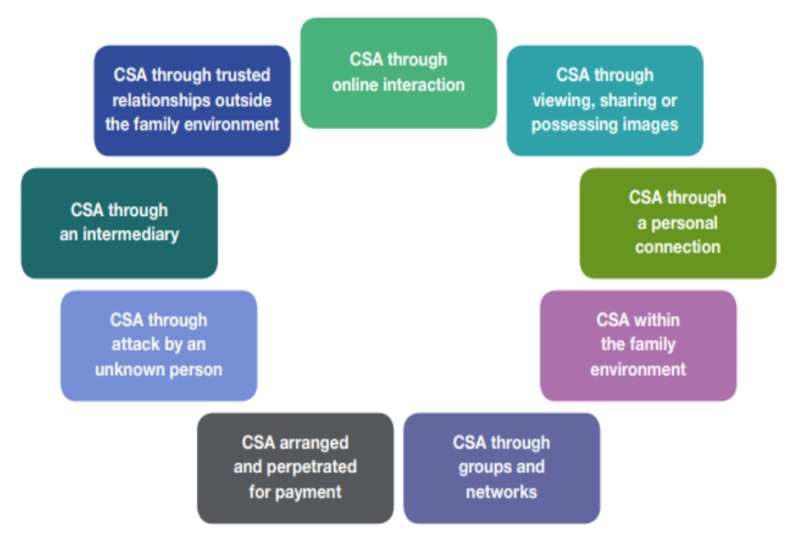
This new typology of child sexual abuse offending has been developed through research led by the Centre for Abuse and Trauma Studies (CATS) at Middlesex University and the Centre of expertise on child sexual abuse (the CSA Centre).
It focuses on the context of offences and draws out types and patterns that reflect different offending behaviours and aims to increase understanding of the nature and dynamics of different forms of abuse. This enables us to view CSA in a new light and make connections between different types of offending.
This is intended to inform rather than direct practice in Devon. It will help improve our collective responses to CSA by developing a stronger, shared understanding of the complexity of this abuse and the many different forms it can take. This will help practitioners see the whole picture of CSA, driving the development of responses and services that better meet the varied needs of those subjected to CSA and survivors by considering the varied contexts in which abuse takes place.
Recognising this complexity is imperative in order to identify, disrupt and deter CSA, and to effectively respond to CYP who experience it.
Using this typology ensures that CSA in all contexts are considered and reflects the latest evidence around known and emerging trends, including:
- Harmful Sexual Behaviour – The National Analysis of Police-Recorded Child Sexual Abuse and Exploitation Crimes Report (VKPP,2022)
- There were around 107,000 offences reported in 2022 – a 7.6% increase compared to 2021, nearly quadruple what it is was 10 years ago. Evidence continues to suggest many crimes remains unreported.
- Around 75% of CSAE offences related to sexual offences committed directly against children, and around 25% relate to online offences of Indecent Images of Children.
- The crime types regarding CSAE are changing. For example, historically Child-on-Child abuse accounted for around third of offences. The data in the report suggests that today this is just over half.
- CSAE within the family environment remains a common form of reported abuse, accounting for an estimated 33% of reported contact CSAE crime. Parents and siblings were the two most common relationships featuring.
- Group-based CSAE accounts for 5% of all identified and reported CSAE ranging from unorganised peer group sharing of imagery, to more organised complex high harm cases with high community impact.
- Reported CSAE is heavily gendered, as expected, with males (82% of all CSAE perpetrators) predominantly abusing females (79% of victims). Sexual offending involving male victims are more common in offences involving indecent images and younger children.
- The number of recorded incidents of Online Sexual Abuse continues to grow. It accounts for at least 32% of CSAE.
- 52% of all CSAE cases involved reports of children (aged 10 to 17) offending against other children with 14 being the most common age. This is a growing and concerning trend involving a wide range of offending. Whilst some include exploratory online sexual behaviours, some of the most prevalent forms include serious sexual assaults, including rape.
- Continue to focus on root causes and the evidence of the relationship between easily available online pornography and HSB, advocating for system wide recognition and interventions that provide CYP with an alternative narrative.
https://www.childrenscommissioner.gov.uk/resource/pornography-and-harmful-sexual-behaviour
https://www.barnardos.org.uk/blog/how-does-pornography-harm-children
https://cease.org.uk/facts/pornography/how-porn-hurts-children/
- Online risk and the rise in boys subjected to sexually coerced sextortion – Internet Watch Foundation, Annual Report – Trends and Data (IWF, 2023)
- Category A - 12 (7%): Images involving penetrative sexual activity; images involving sexual activity with animals or sadism.
- Category B - 28 (16%): Images involving non-penetrative sexual activity.
- Category C - 136 (77%): Other indecent images not falling within categories A or B (Sextortion)
- Sex of children seen in Cat C (sextortion) reports:
- Girls – 10 (6%) / Boys – 161 (91%) / Both – 5 (3%)
CSA – the national picture
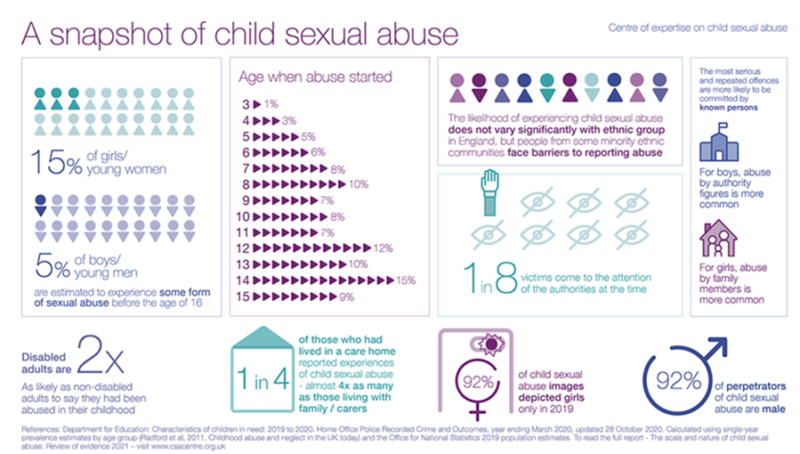
(Centre of Expertise on Child Sexual Abuse)
- 1:10 CYP.
- These do not include 16/17-year olds who are counted in the adult data.
- Those who come to the attention of services are the tip of the iceberg.
- Only 1:8 victims come to the attention of the authorities at the time of the abuse.
They are the victims in 40% of all sexual offences, yet make up only 20% of the population
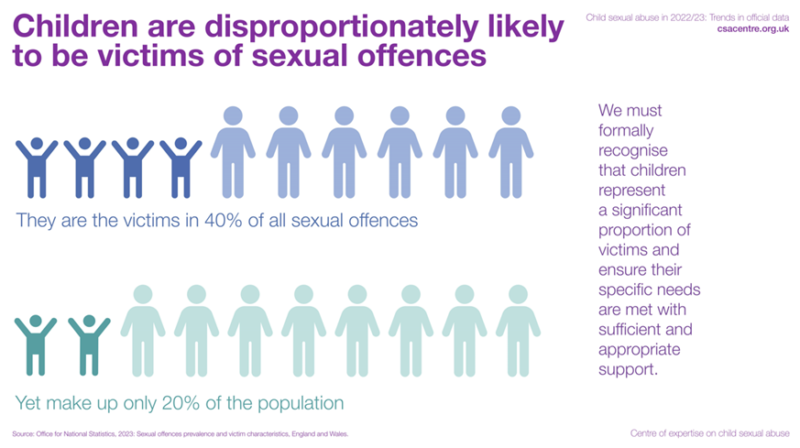
Sexual abuse is just as common as other forms of childhood abuse but concerns are far less likely to be identified and named
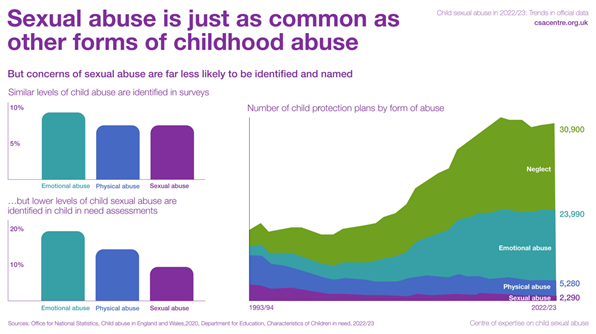
Devon CSA data 2022/2023
The number of assessments naming sexual abuse as a factor
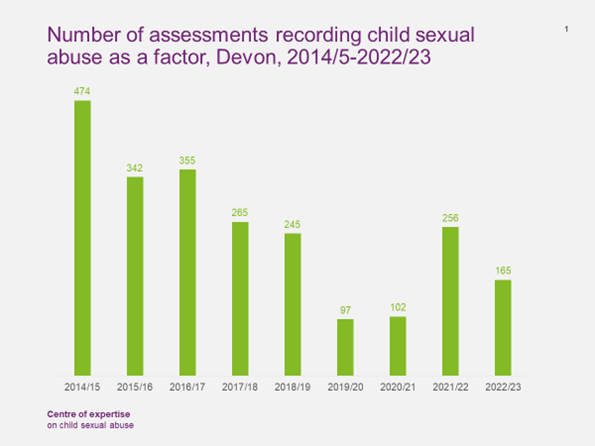
Children assessed at risk of CSA (rate per 10,000 children) compared to statistical neighbours
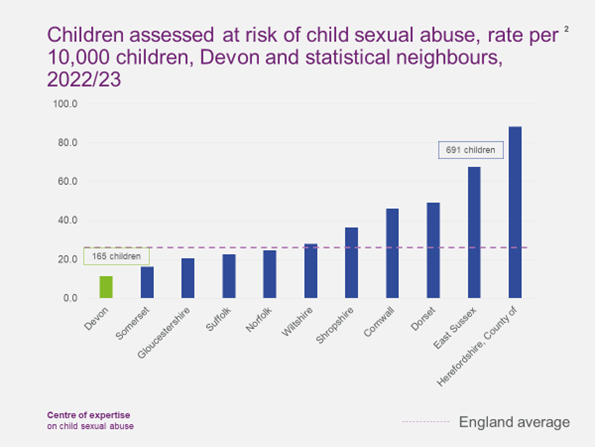
Child protection plans under the category of CSA
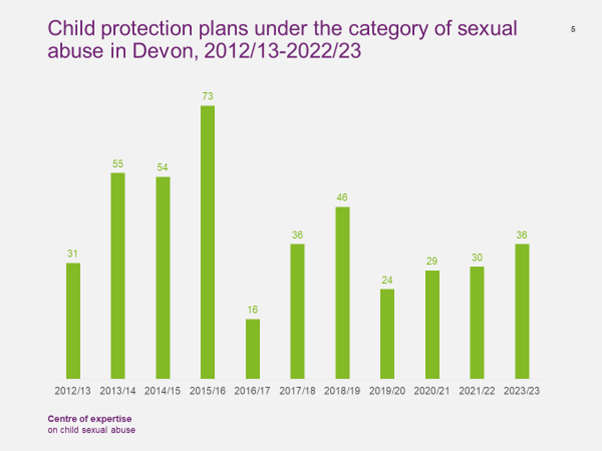
Children on a child protection plan under the category of sexual abuse (rate per 10,000 children) compared to statistical neighbours
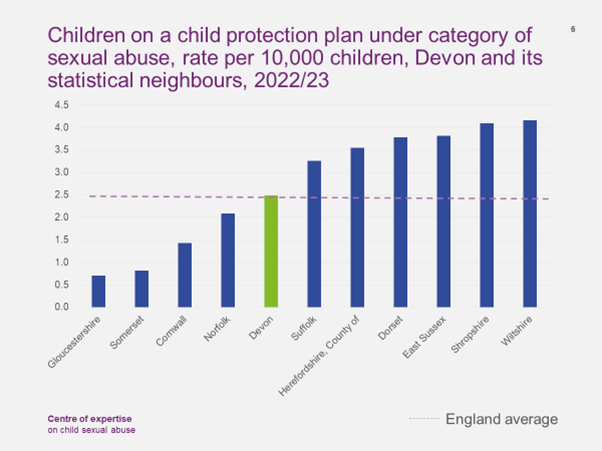
Devon Child Sexual Exploitation data 2022/2023
Number of assessments recording CSE as a factor
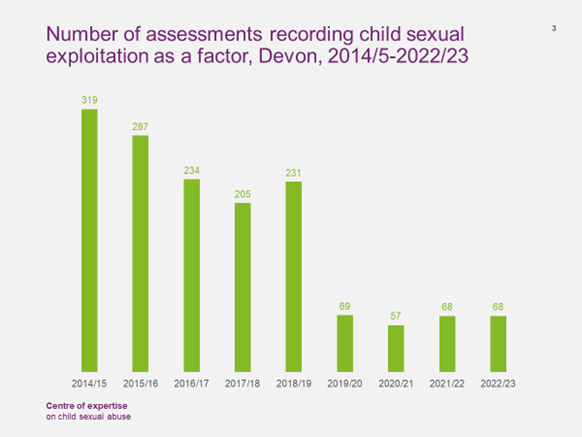
Children assessed at risk of CSE (rate per 10,000 children) compared to statistical neighbours
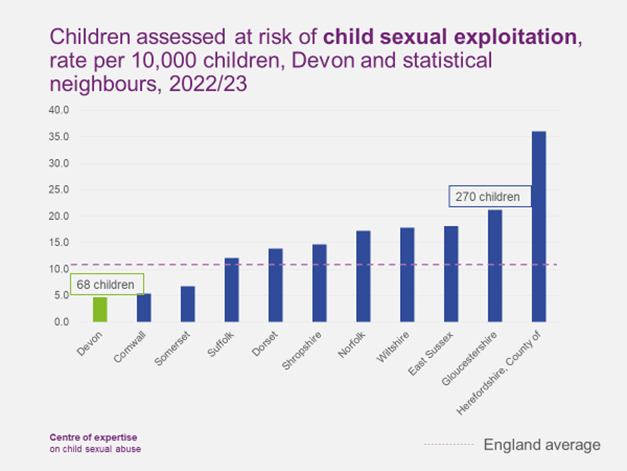
Vision for Devon
Underlying Principles:
- To maintain a clear focus on the child whether they are a victim, or the child or young person who has harmed. With the right interventions, there is evidence that a significant difference can be made to the quality of individual lives.
- The strategy will ensure that the voice of experts by experience continuously informs our response and includes the voice of CYP with lived experience of CSA.
- To work as a partnership, recognising that one agency cannot solve this alone.
Prevention
- Children and young people (CYP) have a good understanding of what represents a healthy relationship and recognise when they are being made to take part in a sexual activity (both contact and non-contact) against their will.
- Children and young people have the strength and confidence to tell someone when they are uncomfortable or unhappy about what is happening to them.
- Prevent child sexual abuse by raising awareness within families and communities.
- Ensure purposeful timely interventions for all children who have been sexually abused or who have displayed harmful sexual behaviours.
- Recognise the influence and raise awareness of easily available online pornography in children’s lives, work as a partnership to develop counter narratives in PHSE and develop confidence in professionals to have conversations about it with children.
- Enable help for adults who have sexual thoughts, feelings or behaviours towards children.
Identification
- That the people children tell listen to them, believe them, support them, and know what to do to stop it.
- Everyone living and working in Devon recognises the signs and indicators of child sexual abuse and thinks the unthinkable, having the strength and confidence to express their concerns without fear. ‘What if I’m right?’ rather than ‘What if I’m wrong?’.
- Professionals are confident and competent in recognising and managing the complexity and tensions inherent in child sexual abuse. That they are comfortable raising concerns and acting on CSA especially intrafamilial abuse which is too often subsumed by other forms of child abuse which are easier to evidence and more comfortable for professionals to work with.
- Increase the knowledge, skills and confidence of workers to identify and respond to child sexual abuse and children with sexually harmful behaviour.
- Increase in Assessment, Intervention and Child Protection Plans for CSA, utilising the data from the CSA Centre to track and evaluate.
- All agencies will be supported to use practice tools from the CSA Centre of Expertise to support a broad response across different contexts
Our Response
- All partners demonstrate complete system leadership in raising awareness and tackling CSA with all partner agencies taking responsibility for professional standards within their own organisations to ensure:
- A shared multiagency approach to identification and interventions for CSA.
- There are clear lines of accountability, roles, and responsibilities in cases of CSA.
- Ensure purposeful timely interventions for all children who have been sexually abused or who have harmful sexual behaviours.
- Multi-agency signup to, and embedding of strategy and ownership of delivery plan.
- Partners collaboratively work towards the commissioning of services that ensure children receive the support they need to recover from CSA and that we use interventions required to assess and intervene to prevent harmful sexual behaviour.
Priorities for Devon
Over the three-year period of this strategy, our priorities are to:
1. To map the current range and quality of interventions across Devon and highlight best-practice to further develop sustainably funded, multi-disciplinary and trauma informed services.
2. Further develop primary prevention in respect of child sexual abuse by continuing and building on our partnership with the Lucy Faithfull Foundation ‘Stop it Now’ campaign, and advocate for system and community wide principles of situational prevention that can make stopping child sexual abuse practical, tangible and something that everyone can understand.
3. Develop a plan to increase the number of recognised child victims of sexual abuse by utilising and promoting the CSA Centre of Expertise Practice Resources including the Signs and Indicators Template and Child Sexual Abuse Response Pathway.
4. Develop a multi-agency quality assurance framework for child sexual abuse in Devon.
5. Review and improve our response to HSB, both for the children harmed and those who have harmed. Promote the use of the Devon’s safe and Healthy Sexual Behaviour forum for consultation. Using the AIM checklist and mapping tools to provide clear analyse and a common language around incidents of HSB. Support the Devon community team providing AIM 3 assessment and intervention with continuous opportunity for professional development and a coherent structure of support. Ensure all staff employed to support the child and family understand the importance of challenging inappropriate behaviours between peers.
6. Ensure full support for victims and their families from disclosure through the full criminal justice journey ensuring support from crisis to long term recovery and increased awareness of the link between domestic abuse and CSA.
7. Ensure a robust approach to identifying and responding to those engaging in abusive behaviours (child and adult) with support and behaviour change programmes available to those engaging in abuse, ensuring they are also held to account as appropriate.
8. Improve public awareness regarding child sexual abuse within Devon.
9. Identify professional learning requirements to support the delivery of this strategy.
10. Ensure a consistent and informed response by multi-agency professionals to CSA, supported by a multi-agency training programme.